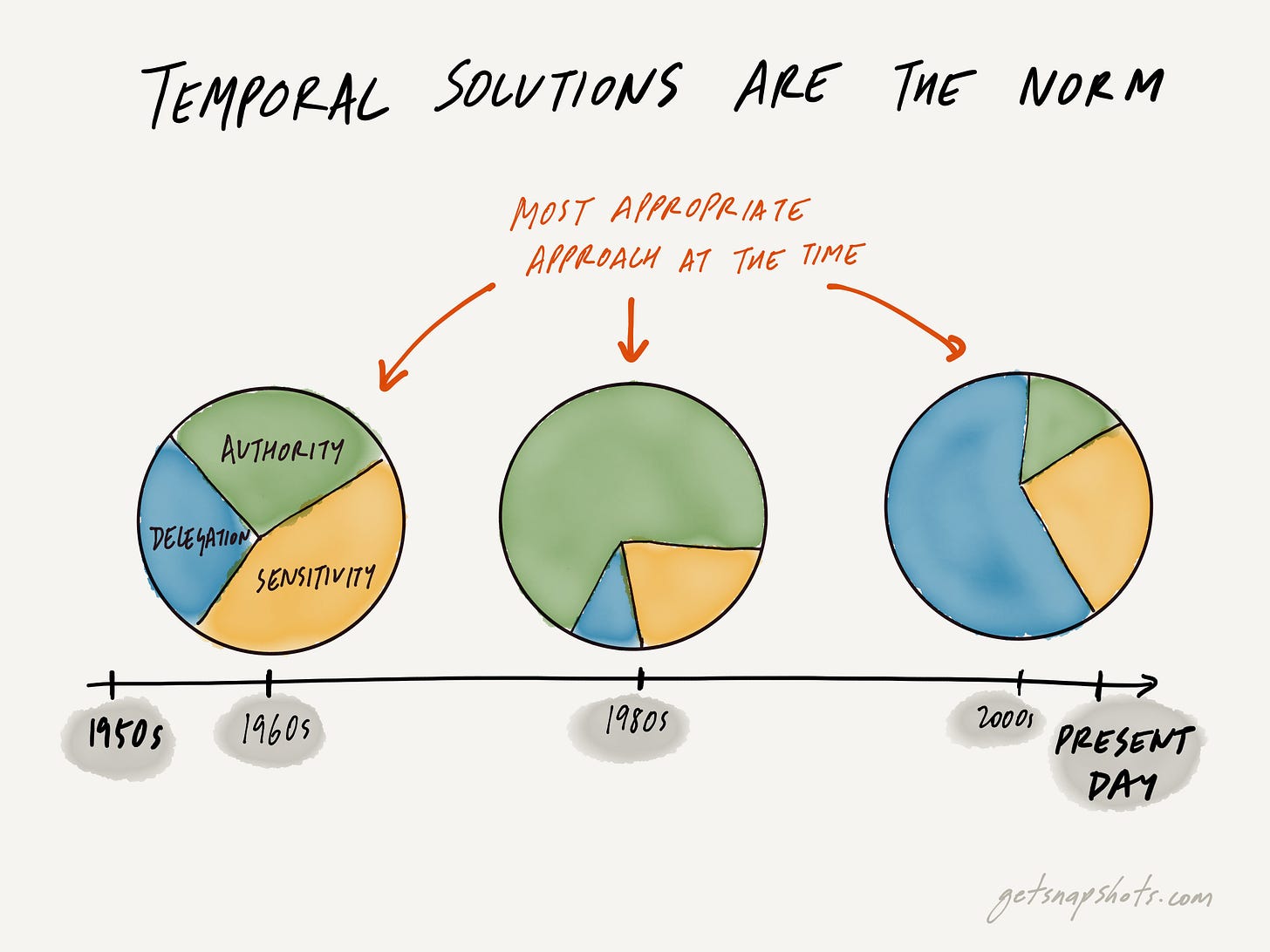Sunday Snapshots (10/04/20) – Dials of governance, Marking misinformation, and How Narvar succeeds in silence
In which I do a deep dive on a company you've interaction with, but have probably never heard of
Hey everyone,
Greetings from Washington, D.C.!
It’s a gorgeous weekend here in the capital. Yesterday, I spent time in the Adams Morgan neighborhood, then some time in Chinatown, and the National Mall.
Today, I wrote an essay about a company you’ve probably interacted with, but never hear of – Narvar. It’s a B2B SaaS company that powers post-purchase experiences for some of the world’s largest brands. I talk about the trends powering it’s silent success, its business model, the risks it has to navigate, and the unique opportunities it has to usher in a new era of retail experiences.

In this issue of Snapshots, I want to explore:
Lee Kuan Yew and my theory of dials of governance
How to mark misinformation
How Narvar succeeds in silence
Kenji Alt-Lopez, Public follow-up, and The Prophet of the Revolt
Book of the week

I would describe the central challenge of leadership as context-switching. As a leader of a country or company, you have many levers at your disposal. Each situation requires a different mindset to solve the problem. I distinctly remember reading the first chapter of Bob Iger’s biography, The Ride of a Lifetime, and thinking about how difficult it must be to switch between opening a new Disneyland location and responding to the Orlando nightclub shootings at the same time. So how do you select which lever to use and to what extent do you use it?
Now, imagine doing that context-switching and lever-pulling not for one day, not for one week, not for a year, or even for a decade. Imagine doing that for three decades.
That’s exactly what Lee Kuan Yew did from 1959 to 1990.
So what can we learn from him?
Over the last three weeks of reading his book, From Third World to the First, I’ve come to see his success through the lens of a theory I would call the “dials of governance” theory.

Here’s what it means: in any given situation, you have a set of dials at your disposal to solve the problem. In the case of the national leader with broad executive power, these tools may fall into three categories: the authoritarian dial, the delegation dial, and the sensitive dial. While not entirely mutually exclusive, they serve different purposes.
Lee Kuan Yew was a master of these dials. Let’s take one example: how to help struggling ethnically Malay kids who were drastically underperforming in school compared to their Chinese and Indian peers? LKY the authoritarian would have implemented a quota system or added cash incentives in the tax code for superior academic performance or any other such measure that ensured equality in numbers.
But in this case, LKY the sensitive prevailed – as it often did when it came to race relations in Singapore. He would consult the Malay MPs (member of parliament – the equivalent of the House in the US – for the non-commonwealth acquainted readers) in his government, get their buy in, and have them present any solutions he had. In many cases, the solutions were changed or at least modified to fit the cultural context. This didn’t mean a free-for-all, all-ideas-are-welcome, let’s-have-a-conversation symposium, but it did mean that the ideas were more bottoms up and perhaps more importantly, were optically less top down.
But how did he have that support structure of Malay MPs in the first place? How did Singapore ensure that there were always Malay MPs in government? Political structures around the world are rife with representation problem and Singapore should be exception, right? LKY the authoritarian shone through here. Constituencies fought election as groups of 3-4 and each group had to have at least one minority candidate. Problem solved – the heavy-handed, authoritarian way.
These dials also have a temporal dimension to them. What worked in the 1970s will probably not work today. Universal principles are often universal in application to all people, but are rarely universal in application across time.

The dials need to be fine tuned over time and iterated changes need to be made to correct for unintended consequences. You can start off as directionally correct and then make some shifts along the way to become magnitudally (not an actual word, but you know what I mean) correct. During this process, while you may have started at the more authoritarian end of the spectrum, you might have progressively dialed it down in favor of delegation. This might remind you of the adaptive walks theory from the summer.
But a more basic question arises. What are the conditions that allow for this continuous iterative process of fine tweaking solutions at the level of a nation state? For LKY, that meant a nation state without an ideology. In an attitude that most distinctly reminds me of Caro’s LBJ whose only ideology was the ideology of his ambition, the only thing LKY cared about was what worked. He was unencumbered by any ideology.
That’s a sobering thought to leave our discussion of the book on. I’ve really enjoyed reading it and definitely recommend it as a primer for anyone looking to learn more about Singapore or Lee Kuan Yew. I also recommend it to anyone looking to expand their worldview of what government’s role in our lives could look like. It’s easy to dismiss something that’s a bit more towards the authoritarian end of the governance spectrum but it takes empathy to understand the path dependence and unique circumstances that lead to the success of a specific model.
Next week, I’ll be back with an equally interesting but less dense biography of one of the best business personalities of the modern era. Stay tuned.
Long read of the week
Designing Indicators to Combat Fake Media by Imani N. Sherman, Elissa M. Redmiles, and Jack W. Stokes
There’s an arms race going on for our attention. If you are a recent subscriber to the newsletter, you might even remember this welcome message from when you signed up for this newsletter:
Our attention is our most precious resource. Over the course of writing Snapshots, I’ve realized that I’m not competing with other newsletters for it. I’m competing with your favorite influencer’s Instagram stories, your friend group’s juicy messages, and the latest fortune cookie wisdom on Twitter. Billions of dollars are spent on making these platform algorithmically perfect to maximize engagement. These are tough enemies to fight in the battle for attention. I’m grateful that you think that I’m good enough to defeat them at least once a week for a few minutes.
But this war for attention isn’t just going on for information. An equal amount of resources (maybe even more) are being diverted towards misinformation campaigns. User generated content on platforms that algorithmically serve up the content that you are most likely to engage with at that point in time and space. Those algorithms do not treat misinformation any different than information. I’m not entirely convinced that they could even if they wanted to – please tell me if I’m wrong here.
That distinction comes with the layer on top of the content. In the last year, we’ve seen a proliferation of markings and highlights on Twitter and YouTube like “[Channel X] is owned by [Government Y]” or “This tweet is misinformation about [Topic Z]. Click to find more.” As the war for attention intensities in a unilateral direction, this “factual or not?” layer becomes more and more important. So, companies are investing to do make them most effective. That’s what this week’s paper by researchers at Microsoft and the University of Florida is about.

This is the design that they found best for marking information. What I’m curious about is how this has structural alignment with the business model – to what extent does the algorithmic server that has been developed over the last decade like these markings? What do the tradeoffs look like? I would love for one of the big algorithmically-driven companies to talk about this in a blog post. In the mean time, enjoy this paper.
Business move of the week
How Narvar succeeds in silence

There’s an accepted sentiment in e-commerce now is that success can only be found by either being the empire or the rebels. The empire consists of Amazon, Walmart, Target, et al where you can buy anything you want. The rebels are powered by Shopify, an association that may be second best only to Apple’s “Think Different” ad driven association with the greatest leaders of our generation.
But there is a growing resistance from the middle. Companies that are neither the empire nor the rebels. Companies that are big enough to do without bending their knees for the empire but don’t want to hang out with the tiny rebels.
Put another way, there are long tails and fat head. But there’s also a big belly of brands to be powered.

This belly might ignored by analysts, but it is not ignored by industry operators. One such operator is Amit Sharma, the CEO of Narvar:

First, #beardgoals. Second, Amit founded Narvar in 2012. It is an enterprise SaaS platform that aims to increase long-term brand loyalty at every step of the post-purchase experience for the customer.
What does that mean?
Odds and ends of the week
One video, one podcast, and one article this week:
👨🍳 Ask Kenji Anything: Kenji Alt-Lopez has been my favorite quarantine find. I really liked this Q&A he did about cooking, business, and life. Hopefully he makes this a recurring segment.
🎙️ Growth Stage podcast about Public.com: If you liked my essay about Public last week, check out this conversation with the Co-CEO of the company, Leif Abraham (h/t long time Snapshots reader Jackson Bubala).
📘 Prophet of the Revolt: One of the most important books I’ve read in 2020 has been The Revolt of the Public by Martin Gurri. This interview with him was a very good followup.
That wraps up this week’s newsletter. You can check out the previous issues here.
If you want to discuss any of the ideas mentioned above or have any books/papers/links you think would be interesting to share on a future edition of Sunday Snapshots, please reach out to me by replying to this email or sending me a direct message on Twitter at @sidharthajha.
Until next Sunday,
Sid